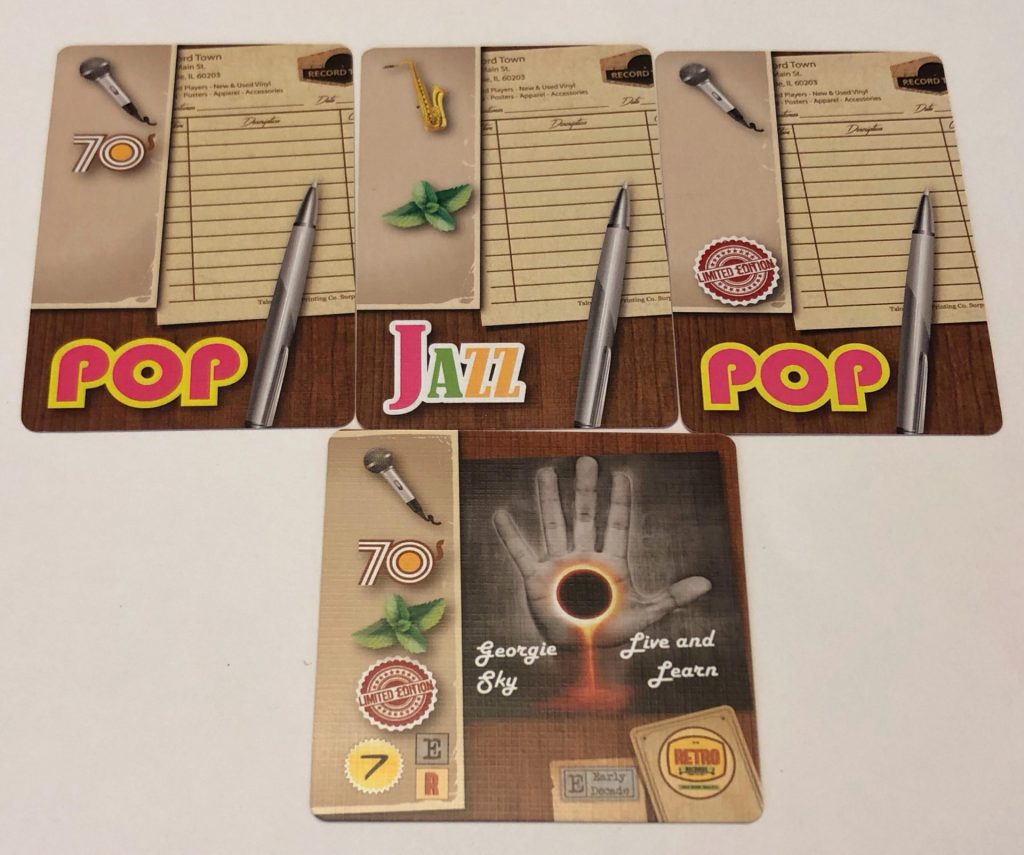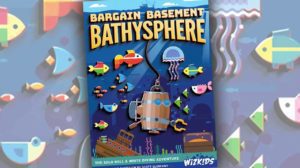Disclosure: Meeple Mountain received a free copy of this product in exchange for an honest, unbiased review. This review is not intended to be an endorsement.
There are few things as central to the human experience as music. For the past century, popular music has held a particular allure. Blues, jazz, rock-n-roll, hip-hop, and country all speak to our lives in ways we may not ever fully understand. Until the advent of the digital age, the record store was the epicenter of popular music. Films like High Fidelity and Empire Records showed how cool it could be to spend your life in one. Combing through dusty stacks of records to find a few hidden treasures was more than just shopping; it was a rite of passage, a religious experience, an initiation into the very mysteries of life itself. From jazz lovers and funk fans to Beatlemaniacs and hip-hop heads, true music fans have always known that there’s only one way to get the most from your music: vinyl.

Basic Gameplay
I’ve been looking through the records
An hour or two
And I’ve about decided
What I’ve got to do
-Tom Tall, “Stack-a-Records”
Vinyl, from Talon Strikes Studios, puts a funky spin on worker-placement by turning it into customer-placement. Each player has a single customer marker, which can be placed at any location on the board to take the corresponding action. There are only 4 or 5 location slots but each location offers a choice between two actions so there’s almost always something to do.
All Hail the Music Magazine
At the top of the board is the Magazine Rack, where players can acquire Magazine cards to add to their hand. Each Magazine card has a set of symbols on it: a genre (Jazz, Country, Rock, or Pop) as well as one of the other attributes in the game (a decade, mint-condition status, and/or limited edition status). These correspond to the symbols found on the titular records, which are laid out in a 4×4 grid to form the Record Bin, with an additional row of 4 cards comprising the Sales Bin. Off to the right of the main display area is the Front Desk, where players can either pick up albums they’ve put on Layaway (albums reserved for later purchase by spending a Magazine card) or change their Loyalty Cards (hidden goals which provide players with incentives to form specific collections).

The Best Place to Pick up New Music
Records are purchased from the Record and Sales Bins by spending Magazine cards. For each icon found on the record, a matching Magazine icon must be discarded. Since each card can have multiple icons, this means that there are always trade-offs to be made: buying the perfect album may leave you bereft of cards, while getting multiple records on the cheap may not move you any closer to your objectives. Don’t forget the other customers, either, because you’re not the only one looking to score that mint-condition 1970s jazz album!

As each record is purchased, a new one will be slid onto the board at the top of the appropriate column in the Record Bin, pushing every other record down one slot. Once all the records have been placed, there’s one final round of frenzied buying before the game ends.
Set Collection
You can’t always get what you want
But if you try sometimes
You’ll find
You get what you need
-The Rolling Stones, “You Can’t Always Get What You Want”
The purpose of getting all these records is to create collections, sets of up to 5 records. At any time a player can have two collections they’re working on, and collections come in two types: Pure and Mixed. Pure collections have one genre (Jazz, Soul, Country, or Rock) and one other shared attribute (such as all being mint-condition or from the 1970s). Mixed collections must have more than one genre – the genre can repeat as long as no two adjacent records have the same genre – and all the records must share either one or two other attributes (Mixed and Double Mixed, respectively).


Players can retire their collection on their turn before or after their action, immediately scoring bonus points based on how many of that collection type have already been scored. Larger and more difficult to achieve collections are naturally worth more points, with Double Mixed generally being worth the most and Mixed the least. At the end of the game, each record will also be worth a number of points printed on its face, and players will gain additional points for meeting the conditions on their loyalty cards. Point totals can be large, somewhere around 150 points per player, so the math-averse should make sure to have a phone or calculator handy.

Bump Actions
Come on now
Come on, let the music get you movin’
Let ‘em see that you’re not losin’
-The Kinks, “Come On Now”
What makes Vinyl sing, however, are the bump actions. Unlike most worker-placement games,occupying an action slot doesn’t prevent other players from using it. Instead the active player can claim the action slot, pushing the customer on that space to a secondary bump slot. The bumped player then gets to take a completely cost-free bonus action according to their new position. If someone gets bumped from there they don’t get any further actions, so there’s no chaining bumps. This is a record store after all, not a mosh pit.

The bump mechanic isn’t new, but it is perfectly utilized here. There’s something cathartic about literally pushing someone out of the way to get that limited-edition record, and it adds an interesting wrinkle to each game decision. One of the more common bump actions allows the bumped player to take a single card which the active player spent to acquire a record. Spending a Wild card to get that perfect piece feels a lot worse when your opponent pulls the Wild card out of your hand and immediately uses it to buy the perfect thing for their collection.
If you’re interested in seeing very different takes on the bump mechanic, check out our reviews of Charterstone as well as Abomination.
Components
Sara (spelled without an ‘h’) was getting bored
On a Peavey amp in 1984
While Zak-without-a-C tried out some new guitars
Playing Sara-with-no-H’s favorite songs
-Ben Folds, “Zak and Sara”
On first blush, Vinyl’s components are really impressive. The sepia tones of the board look great and instantly bring to mind the feel of vintage vinyl, wood-framed phonographs, and newsprint ‘zines. The record albums are a delight to look through, with a variety of art styles, some fun wordplay, and several clever parodies. The miniaturized crate and its dividers are perfect, and the disco-pose customer markers – or the miniature guitars, for those who received the Gold Edition – are fantastic.

Unfortunately a few issues detract slightly from the experience. For one, some of the album art has illegible lettering or art that feels so minimal as to be incomplete; thankfully neither affects gameplay. However, there are also some readability issues with the board. Those evocative sepia tones are used everywhere: the Magazine cards, the Record cards, and on multiple layers of the board itself. It all starts to blend together into one brown whirl, so much so that in our first play, an entire action slot was overlooked for fully half of the game. The dull red “Limited Edition” attribute logo is similarly easy to skip over when trying to parse 20 different records, which is frustrating both when you’re trying to find it and when you’re about to collect a record only to discover you don’t have the requisite card.

These aren’t deal-breakers; they’re minor annoyances, like the occasional pop or hiss of a well-worn record. Still, it’d be nice to see these details remastered for any future printings, because a few tweaks would make the whole game feel even richer and more thematic.
Solo and Two-Player Modes
With the record selection
And the mirror’s reflection
I’m-a dancing with myself
-Gen X, “Dancing With Myself”
In addition to the standard rules for 3-5 players, Vinyl includes rules for solo and two-player games. In both cases, the game uses a Non-Playable Customer (bot) to simulate the presence of another player. The NPC has a limited script it can follow which helps ensure that human players can occasionally take advantage of bump actions and keeps unwanted records from sitting around on the board.
It’s a much-appreciated gesture and both rulesets are serviceable. However there are definite pacing issues in these modes. Because the bump actions often accelerate other players and the game’s pace is determined by the speed at which players purchase records, having fewer than 3 humans makes it feel as though the game is being played at the wrong speed, like playing a 45 rpm single at 33 ⅓ rpm. It can still be fun, but it’s just not the same, and I wouldn’t recommend purchasing the game for exclusively 1-2 player play.
Final Thoughts
Try to describe it to the limit of my ability
It’s there for a second then it’s given up what it used to be
Contained in my music somehow more than just sound
This inspiration coming and twisting things around
-Operation Ivy, “Sound System”
There’s a great story about seminal punk band The Clash. During a recording session, the band laid down a fantastic version of Vince Taylor’s “Brand New Cadillac”. Unfortunately, on replay, it was obvious that the band had sped up part-way through, so that the end of the song was faster than the beginning. The band members were all set to throw it out and start again when their producer convinced them to keep it with one single, brilliant sentence: “All rock and roll speeds up.” The point, of course, is that sometimes musicians need to let their passion take precedence over the technical aspects in order to create a great song.

That idea kept cropping up in my mind as I played Vinyl. It’s not a perfect game. There are a few typos in the rulebook (including a major one that lists the incorrect number of Magazine cards as 72 instead of 64), some design issues on the board and the album art, and the gameplay can occasionally bog down if players don’t push the pace. Yet I found myself still happy to play it, my fingers flicking through the records, smiling at a clever album cover or cursing myself for not grabbing the one thing I needed when it was in the Sales Bin.
It’s obvious that Vinyl is a work of passion. There’s a deep love for the theme that carries through in so many details that a few odd issues are easy to overlook. Each moment of this game spoke to me, reminding me of bygone days when the music was all that mattered. Vinyl may not be for everybody, but if you can lose yourself in its rhythms, it’s a smash hit.
If you’re interested in taking Vinyl for a spin, then you should also check out our review of Vinyl: Big Band, an alternate take on the original game.












Excellent review, I have enjoyed this game so far. I agree with you that some of the aesthetic choices are problematic, but I think this is a case where all of the good choices outweigh the bad by a wide margin. I am happy with it, and I feel the KS campaign was well-run.
P.S. – I don’t know if I imagined that this was in the rulebook, but we have been playing that you cannot take a spent wild from another player. It makes the bump action seem a little more balanced.